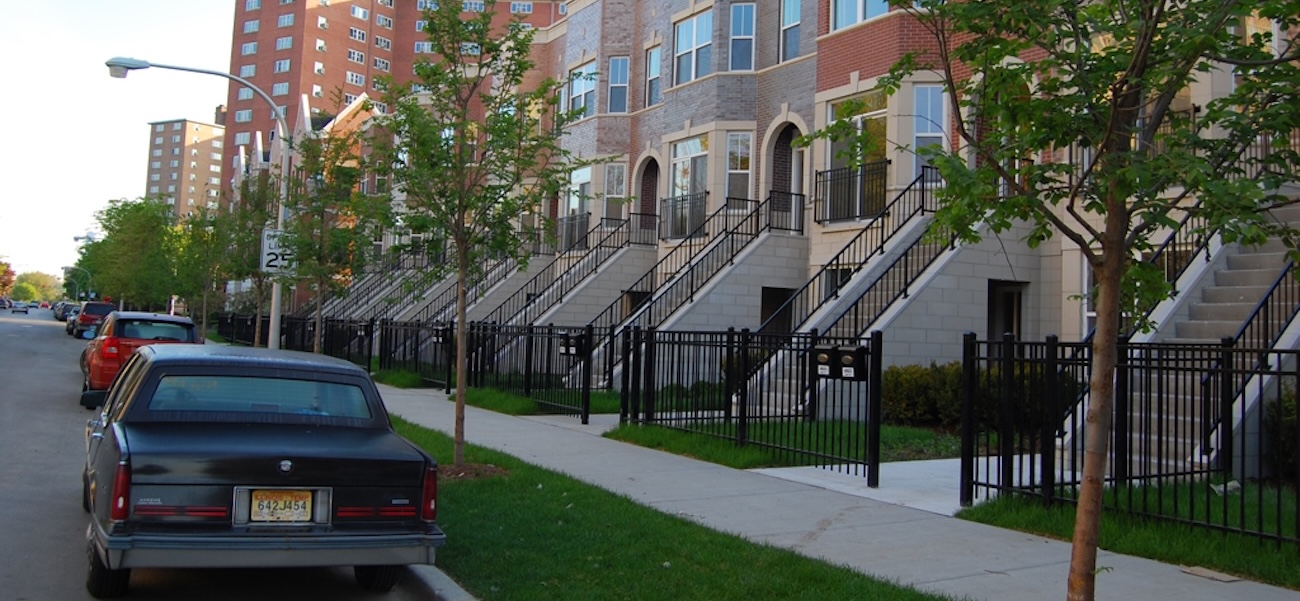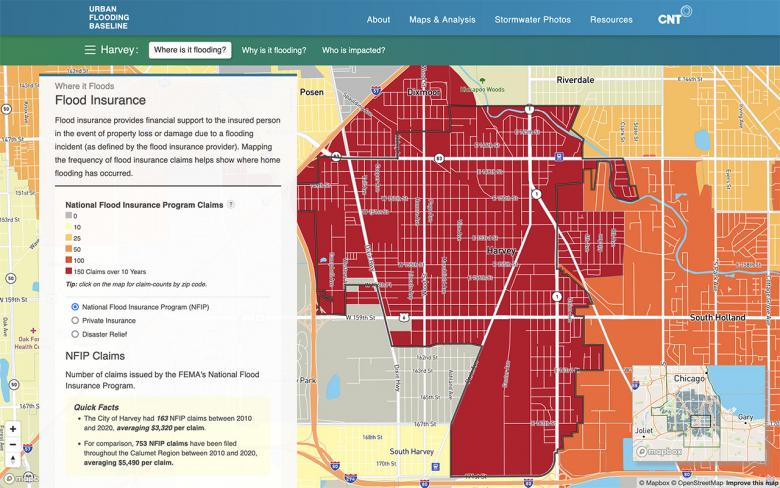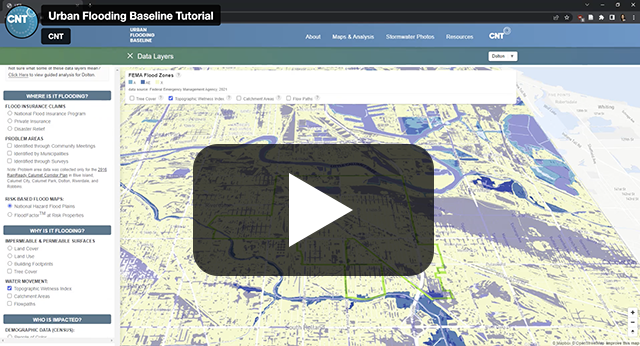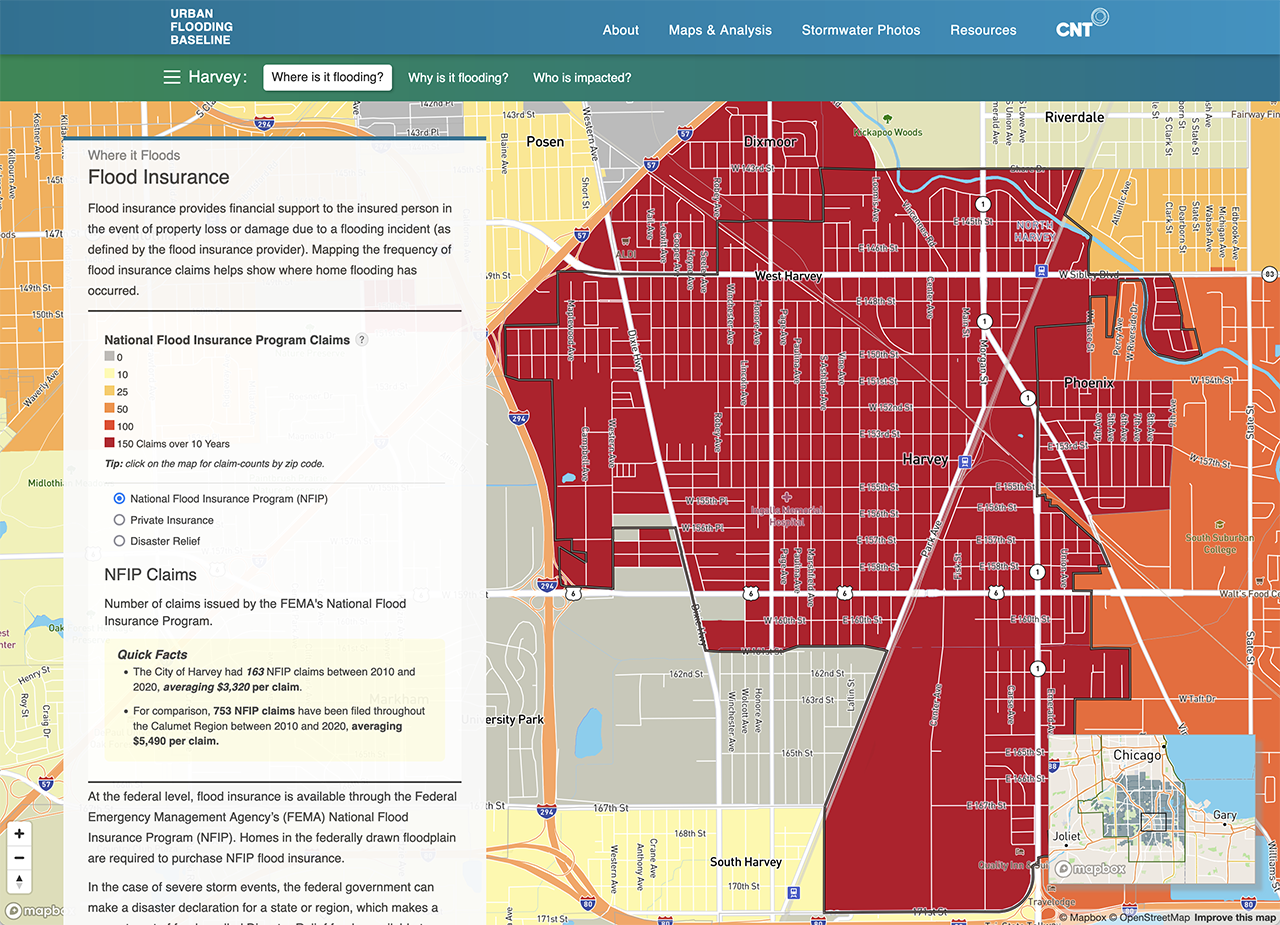CNT’s exploration of urban flooding
CNT has worked on urban flooding for several years, focusing specifically on urban flooding because of the realities in Chicago and Illinois more broadly.
FEMA's Flood Insurance Rate Maps create floodplains based on flooding from bodies of water. But based on personal experiences and relationships with residents and local professionals, CNT knew that many homes in the Chicagoland area are impacted by flooding despite being outside of flood plains. CNT analyzed flooding insurance claim data, 3-1-1 data, structured interviews, and community forums to understand the extent of flooding in Cook County.
CNT began work around stormwater management in the south suburbs after a 2013 flooding disaster in Cook County, which severely impacted the Calumet region. The reality that flooding occurs outside of FEMA Floodplains posed a significant challenge for homeowners and renters who could not access enough funds for post-flooding recovery.
In 2019, in conversation with the Calumet Stormwater Collaborative, CNT embarked on developing the Urban Flooding Baseline to consolidate data on known flooding occurrences and explore factors that might impact flooding.
Visit the Urban Flooding Baseline tool here: ufb.cnt.org
What sets the Urban Flooding Baseline tool apart
Audience: Over the past year, CNT focused on creating an educational tool for residents, community leaders, and elected officials so that they can jump into conversations and data about urban flooding. We settled on this audience because often stormwater management professionals already have many tools and quantitative data sets (though imperfect) to understand the nuances of flooding. However, those who are directly impacted by flooding – residents -- are often left stranded to deal with flooding individually with little to no opportunity to understand where and why flooding is happening and few tools on how to collectively work towards mitigating the damage.
Advisory Group: This tool is the first time that CNT has attempted compensated community science work. Fifteen residents collected over 4,000 photos between March 2021 and May 2022, documenting storm impacts across seven municipalities in the Calumet Region. Read about the pilot here and see the data under the stormwater photos section of the website. Critical to implementing the community science work was CNT’s advisory group of residents and a partnership with South Suburban Mayors and Managers Association. Residents who had previously worked with CNT during the RainReady Calumet Corridor plans were tapped (and compensated) to help CNT plan a thoughtful community science process and provide feedback on tool development from start to finish. Their comments informed CNT’s innovative approach to the tool.
Urban Flooding Baseline User Guide
Watch this short video tutorial to learn about how to navigate the many resources of the Urban Flooding Baseline tool.
Mapbox Interactive Storytelling: Once CNT had refined the audience, staff found it imperative to contextualize the data to provide residents with the information needed to understand why the data was shared, how data layers related to one another, and what were the limitations. Mapbox’s Storytelling platform provided CNT with this ability. Viewers can see maps visualizing the data overlaid by side “cards” that inform why this data layer matters and data-informed quick facts about the municipality. For some data layers, CNT further visualizes the data into graphs and shares additional data resources for viewers to explore. Some of the text makes transparent the data limitations. In doing so, CNT invites viewers to consider how their lived experience aligns with or exposes data gaps. Informed by data and information, CNT hopes residents can feel more prepared to advocate for changes from their elected officials.
Actionable Resources: Early on, the Advisory Group members made clear that this tool cannot stop at only identifying the problem. For a webtool to empower residents, residents need to be aware of paths forward. Thus, CNT developed two resource pages: “Homeowner Guidance” and “Community Advocacy.” Homeowner Guidance provides a list of resource links with actions on how to anticipate, prepare for, prevent, and recover from home flooding. Community Advocacy provides suggestions on how to organize fellow neighbors to make changes so that the municipality can work together to address flooding collectively. The suggestions are drawn from advisory group members and staff experiences as well as findings from the storytelling section.
With these resources, the tool does not limit itself to a data hub, rather it shows that data tools can be a resource to support collective action.
What’s next
Over the next few years, CNT will be using this tool to further its other south suburban projects. CNT will be administering Cook County's American Recovery Plan Act (ARPA) funding dedicated to implementing the RainReady Calumet Corridor plans and running a civic innovation hub which is a collaborative space created for residents, municipal staff, and officials to engage in dialogue, thought partnership, and training on stormwater management.
We hope that you take the time to visit this new tool!





 Strengthening Transit Through Community Partnerships
Strengthening Transit Through Community Partnerships



